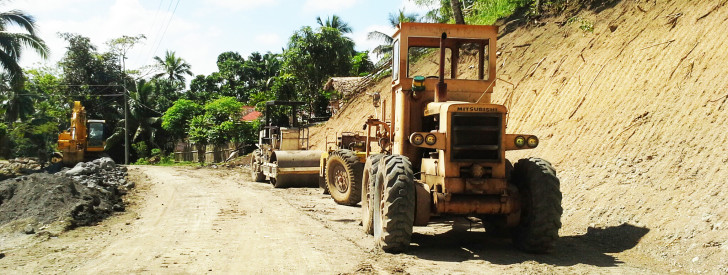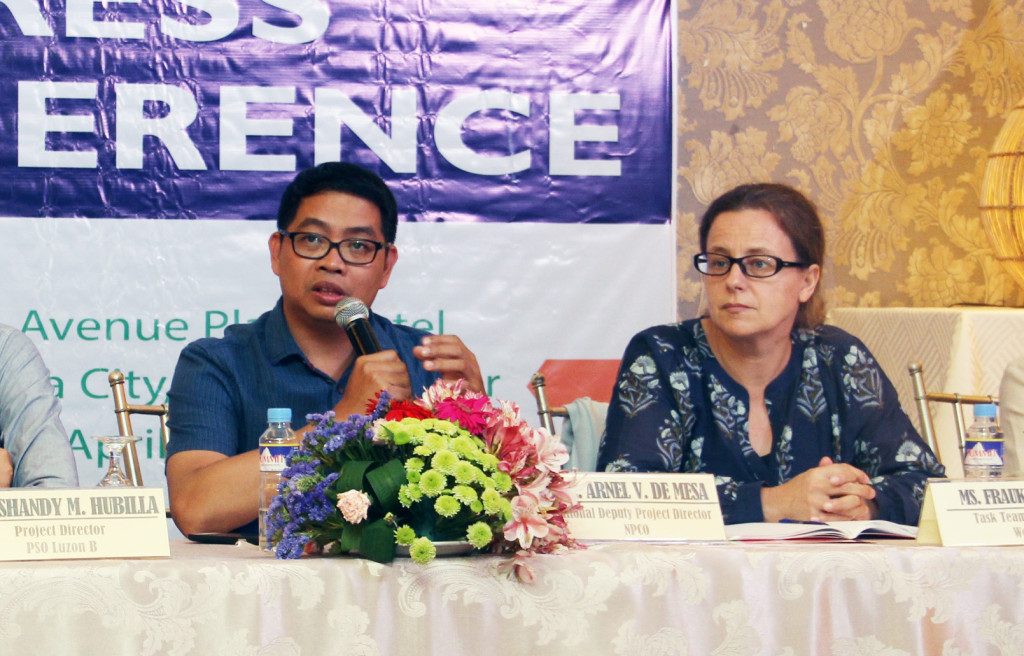 GEOTAGGED. The site photo of the “Rehabilitation/Improvement of Pistola-Tablon Road with 3 Units Bridges” sub-project during the sub-grade preparation has been uploaded and placed on Google Earth for a more convenient project monitoring.
GEOTAGGED. The site photo of the “Rehabilitation/Improvement of Pistola-Tablon Road with 3 Units Bridges” sub-project during the sub-grade preparation has been uploaded and placed on Google Earth for a more convenient project monitoring. PRDP prohibits “Roads to Nowhere”
“Dito sa PRDP, bawal na bawal ’yung tinatawag na roads to nowhere (In PRDP, the so-called roads to nowhere is a big no),” expressed PRDP National Deputy Project Director Arnel De Mesa during the press conference for the World Bank’s 2nd Implementation Support Mission to the PRDP South Luzon cluster.
Representatives from the press asked questions on how PRDP projects stay away from political colors and avoid substandard farm-to-market roads.
Director De Mesa highlighted PRDP’s use of science-based tools to protect its projects from political anomalies that would compromise the quality of roads. He said that PRDP uses applied geotagging tool, wherein sub-project activities and accomplishments are documented with photos that are geotagged or uploaded online and placed on the Google Earth. He added that the tool is used starting from the project identification to its completion and geotagged photos are not ordinary photos.
PRDP’s geotagging camera android application has enhanced security features that can detect illegal photo modifications. According to an earlier interview with Joseph Pacon, alternate unit head of PRDP’s Geomapping and Governance Unit, the use of geotagged photos and online field monitoring and project evaluation or the so-called virtual tour can be compared to photo forensics. He said that through the virtual tour, the implementers can track and investigate the progress of sub-projects. Engineers from PRDP’s I-BUILD or infrastructure development component can observe the road conditions and quality of substance used through geotagged photos.
The press also asked questions on how PRDP sub-projects are identified and how funds are distributed among different municipalities nationwide.
Aside from the geotagging tool, Director De Mesa also emphasized PRDP’s use of vulnerability and suitability assessment (VSA) to avoid the intervention of politicking groups. He added, “This project is what we call commodity-driven and demand-driven. The cost of the project is dependent on the proposal submitted.”

PRDP National Deputy Project Director Arnel De Mesa (left) expressed his confidence on PRDP sub-projects, while Ms. Frauke Jungbluth (right), Lead Agriculture Economist and Task Team Leader from the World Bank listened. (Photo Credit: Eduardo D. Collantes Jr.)
Instead of allocating specific funds for every municipality, PRDP starts with value chain analyses (VCAs) and provincial/city commodity investment plans (P/CCIPs) to identify strategic locations for farm-to-market roads that will link production areas to the market.
Infrastructure development sub-projects that include farm to market roads and enterprise development sub-projects of PRDP are all based on the P/CCIPs of the proponent local government units (LGUs).
As of March 2016, the South Luzon cluster’s I-BUILD component has 95 sub-projects worth 8.59 billion, 35 of which worth 2.74 billion are under implementation. The cluster’s I-REAP or enterprise development component, on one hand, has 198 sub-projects worth 639.84 million, 157 of which are small enterprise projects and 14 are Global Environment Facility projects in Marine Protected Areas.
PRDP’s I-PLAN or local and national level planning component is responsible for guiding and mobilizing Regional Project Coordination Offices and Provincial Project Management and Implementation Units in doing VSAs, crafting VCAs and PCIPs, and having them endorsed by Provincial and City Development Councils.
On the concern about the Philippine government’s loan from the World Bank, Director De Mesa stressed the role of LGUs on proper project management and monitoring.
PRDP South Luzon Project Support Office Director Shandy Hubilla said, “World Bank is a bank, but it is a development bank. What they are after is development, in this case, rural development.” He further explained, “The payment for them is to see the development in the countryside through the fund they have provided. We have to loan and the benefit will come two to three years from now. We would like to remain true to our tagline: ‘Enabling communities, Expanding Opportunities’.”
As a World Bank-funded project, PRDP goes beyond politics according to Director Hubilla, because the bank has technical procedures in project evaluation and it does not look at the political color.
Director De Mesa guaranteed the press about PRDP by saying, “Makakaasa po kayo sa project na ito (You can rely on this project).” ### (Gumamela Celes Bejarin, DA-PRDP PSO South Luzon InfoACE Unit)
